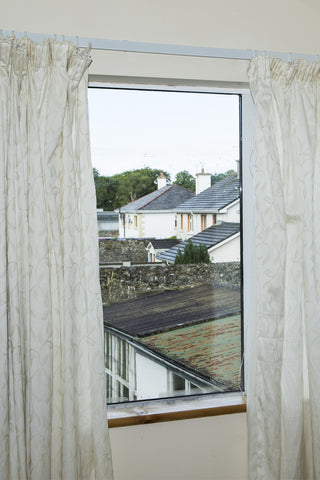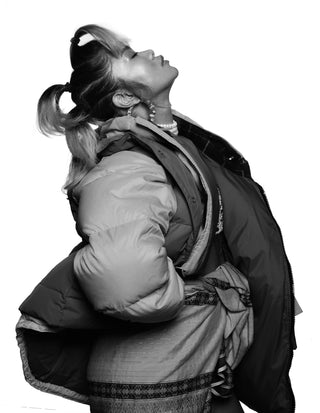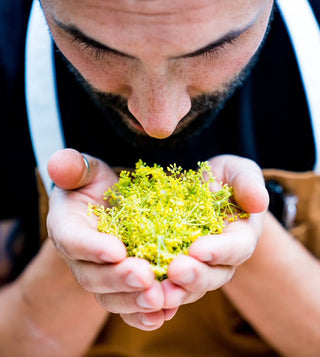Over the years we have admired Jeremy’s work from a distance, longing for an opportunity to collaborate. As chance may have it, time and space aligned for us to work together shooting actress and producer Dolly Wells in New York.
With an openness to explore and question, Jeremy Liebman’s eye for the sublime challenges visual assumptions and the act of seeing itself. Inspired by his family and the intangible, his work spans from Vogue Japan, the Met, Etudes, Nike and AD to name a few.

- What was an early experience where you learned that your photography had power?
-
There are (at least) two ways to think about photography having power. One is in its ability to create social change or upset existing power structures. The other is a softer form of power that creates an intimate space or moment between the author and the viewer of the photograph, something more akin to fiction or poetry. I’m much more interested in the latter.
My dad taught me how to take pictures my first year in college, in a pre-digital time, when the time between taking the picture and seeing the results could be weeks. Usually, the results were disappointing — things almost always looked better through the ground glass. But sometimes I would be surprised by an image, and sharing it with my dad, he would see something in it as well. That felt very powerful to me at the time, and that ineffability is still what I respond to in any photo. - Your father was a serious amateur photographer. How does it feel to share photography as a family core?
-
When I was born, my dad had a Leica and an Aperture subscription, and a love of gritty black-and-white street photography. He tried to open a professional portrait studio, with no luck. When I was growing up he would sometimes sit my brother and I in front of a backdrop to test lighting setups on the weekends, not how any kid wants to spend their Saturday afternoon. I had no interest in photography at the time, and thought it was the last thing I would ever want to dedicate my life to.
There’s a strange and very specific memory I have, walking one sweltering Dallas summer morning to my internship in the IT department of a downtown law firm, where my interest in computer programming was plummeting with every passing day. There is a depressingly byzantine system of underground walkways between buildings in downtown Dallas (the mayor once said “ if I could take a cement mixer and pour cement in and clog up the tunnels, I would do it today.”). My mom worked downtown too, so we would drive together to the elevated parking garage, and I would descend an escalator from a skybridge, down to a small courtyard, the only naturally lit area on my commute, before entering the dim subterranean network.
I remember seeing something in that little pavilion between the air-conditioned skybridge and the air-conditioned tunnels that I felt needed to be captured and elevated from its surroundings, something poignant. I remember the place and the light vividly but for the life of me, I can’t remember what the object was — a scrap of paper with some text, maybe? But it was a turning point, and I asked my dad if he would teach me how to use a camera. That summer I studied everything on his bookshelf — Brandt, Avedon, Arbus, Penn, Koudelka, and many others.
-

- Beyond your primary creative drive, what else do you explore?
- I was a debater in high-school, and that tendency to question and prod the way things work is still with me. The reason I ended up doing the type of photography I do is to be able to branch out into all kinds of different fields — food, science, architecture, literature, music, film, etc. I used to feel somewhat insecure about being a generalist, rather than a singularly-minded artist, but I’ve come to see that broadness is essential to who I am.
-

- What creative pilgrimages have you gone on?
- Several years ago, I took a trip to meet some friends in Galicia, Spain in a town called Finisterre, once thought to be the literal end of the Earth. My friends were completing a walking pilgrimage of the Camino De Santiago, a pilgrimage route dating to the Middle Ages and possibly as far back as Roman times. I took the easy route and flew to Santiago and took a bus to Finisterre, where I met them at dusk, on the beach, at the end of their 2.5 month walk. We found a small restaurant where we were the only customers and drank Albariño and ate percebes for hours.
- Across your work, there is an eye for sublime happenstance, of a moment captured just before it fades. How do you define your relationship to the fleeting moment?
- I’ve always felt that if there’s something surprising or mysterious to me, that will translate to the image, even if it’s not something I can put my finger on. In pictures, as in life, surprise is inherently fleeting; if you look long enough you can usually unravel the mystery, so my goal is to take the picture before I fully understand what I’m seeing.
-

In pictures, as in life, surprise is inherently fleeting.
- Is there a feeling or memory you are chasing you wish to find again?
- I think many of us have a feeling that the things we experienced when we were younger were somehow more real. There are vague, amorphous memory-sensations that I have from my childhood — rooms or times of day — that are loaded with ambiguity, because at that point I didn’t have a framework in which to put the experience, so I just existed within it. Those are experiences that I long for, to put the thinking mind aside, and just be. In my work, I want to create images that have a similar openness to them.
- What is your idea of intuition?
- Intuition is very important for me, as a form of trust in or curiosity about the subconscious, a move away from analysis, which is the best way I can feel something approaching the mystical. Photographic projects that set out to illustrate a preconceived thesis are always DOA, so being able to listen and adjust is important.
-

- You have spoken about how photography abstracts — it dematerializes a subject and puts it on another plane. Are there specific elements you look to abstract in your photography? Are there elements you wish to convey truth?
-
I’ve always found the supposed distinction between abstraction and realism to be fascinating, and somewhat counterintuitive. What we think of as “realistic” will inherently abstract the world by translating our sensory input into categories that are devised by the mind. If you see a painting of an apple for example, your brain is doing some calculations and making assumptions about paint on canvas and making associations towards an object or type of objects in the real world.
Similarly, art that is often labeled “abstract” is sensed directly by the viewer, unencumbered by ideas, in a way that is concrete. Robert Ryman for example made white paintings that are often referred to as abstract, but are about how white paint looks in different arrangements, under different lighting conditions, on different surfaces. In that regard, the act of seeing is one of the few things that isn’t abstract at all.
So in photography, I want to create images that challenge the visual assumptions we make all the time. I want you to think twice about the role of the objects that I include in the frame.
If you think of a photograph as having an emotional component and a content component, I want the emotional component to be as true as possible, while the content is abstracted from its expected role.

- What role does an abstractor play?
- The abstractor in photography, at least one working only with the material the world provides, must find ways of selecting, both in composition and in editing, that emphasizes the ways in which the world we think we see is not the world as it is, making the strange familiar and the familiar strange, to borrow a well-worn phrase.
- What is a thought that has been on your mind?
- I recently finished George Saunders’ new book A Swim in a Pond in the Rain. It analyzes seven Russian short stories by Chekhov, Tolstoy, Turgenev, and Gogol (it’s more funny and lively than it sounds), and it’s the best thing I’ve ever read about the creative process. It got me thinking a lot about the act of revising and editing, how the final work is informed by what is selected and shown, rather than the romantic (but usually wrong) idea of a brilliant first draft, pouring fully formed from the artist.
- Your job requires you to travel and meet many people, are there constants you find across settings and situations? Have you found something unexpected that unites us in our humanity?
- For me, the point of traveling is to be open to the experience, so I try to keep expectations and conclusions to a minimum. I want to absorb as much as I can without reducing it to my own small way of thinking.
- What is a constant ritual / routine / space you carve for yourself in your life?
- I have a 2 year old daughter, Vivienne, and I put her to bed every night. I’ll sit in a darkened room for anywhere from 20 minutes to an hour (or more on rougher nights) waiting for her to fall asleep so I can creep out. Sometimes it’s frustrating and sometimes it’s relaxing, but in any case it’s good to turn off for a small period of time every day.

- Where do you go to replenish and inspire yourself?
- For a walk.
- What are you interested in exploring?
- I recognize it might not be all that interesting to hear someone talk about how much they love their kid, but it’s the truest answer to this question. Watching our daughter grow and change is a constant joy and surprise, and a reminder of how fluid everything always is.
- What gives you hope?
- Vivienne.


